The Last Plague: Spanish Influenza and the Politics of Public Health in Canada

Support Canada's History in other ways (more)
by Mark Osborne Humphries
University of Toronto Press, Toronto, 2013. 336 pp., illus., $32.95 paperback
Canada’s sixty thousand Great War dead were a collective spectre over the young Dominion. Almost every community from across the country had bled for the victory. In the war’s terrible aftermath, with a fragmented country facing debt and uncertainty, Canadians banded together to build memorials to the fallen. Throughout the 1920s, and continuing episodically to the present, thousands of memorials were erected, with the names of the killed etched in stone, as a constant reminder of the nation’s sacrifice for King and country.
Yet, even as the last shots were fired on the Western Front on November 11, 1918, thousands of Canadians were succumbing to a lethal plague. This pandemic attacked young and old but was especially deadly against normally healthy Canadians in their twenties. The Spanish flu as it was known — it was reported first in Spain, where there were fewer military censorship regulations — raged throughout the world, spreading terror just as millions of soldiers were demobilized from the fighting armies to return to their homelands. Often the flu was waiting for soldiers in their communities; they arrived home not to cheering crowds but to silent graveyards.
The flu was the stuff of nightmares. Hitting Canada in three waves over 1918 and 1919, it was an unusually virulent and deadly respiratory disease that was transmitted through human contact. There was no cure. Like in the war, some lived and some died. Across the country, families were wiped out. Mass graves were filled. Social gatherings were cancelled. Men, women, and children walked in fear, with white-gauze face masks covering their noses and mouths. Terror stalked the land.
Mark Humphries, one of Canada’s leading Great War historians and a professor at Memorial University, has researched in multiple archives to reconstruct the disease and its effect on Canadians. The first three chapters of The Last Plague contextualize Canada’s previous pandemics and diseases, especially the cholera outbreaks of the 1830s. Humphries provides new evidence regarding medical authorities’ attempts to quarantine the infected. The core of the book focuses on the waves of flu that hit Canada, with the most deadly occurring over the winter of 1918–19. Two final intriguing chapters explore how Canada’s public health governance developed in the flu’s aftermath, telling us much about the interaction between civilians and the state in the sphere of health in the 1920s.
This fine book chillingly dissects the disease as it burned through Canada as well as the failed attempts by authorities to stop it. In the end, some fifty thousand Canadians were killed over a period of less than a year (and somewhere between fifty and one hundred million worldwide — the wide variance being due to poor record-keeping in many Asian and African countries).
In Canada, the number of monthly deaths was far higher than anything experienced during the terrible Great War. But, unlike the wartime sacrifice that continues to live on in public memory through anniversaries, books, movies, and acts of remembrance, there are only a handful of memorials to the Spanish flu victims of 1918–19. Humphries’ The Last Plague may not be a memorial to the dead, but it is a detailed, scholarly reminder that the flu had a tremendous impact on Canadians, and then on public health care. It also reminds us that the plague deserves a place in our collective memory.
— Tim Cook (Read bio)
Tim Cook is a member of the Order of Canada and the author of eight history books, including Fight to the Finish: Canadians and the Second World War.